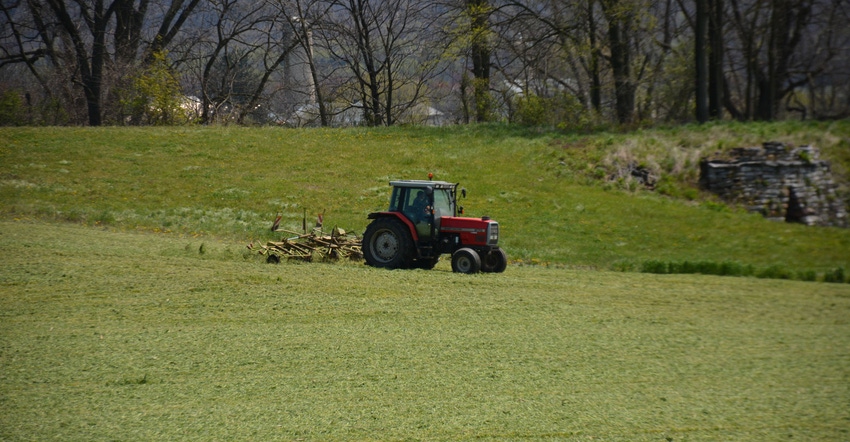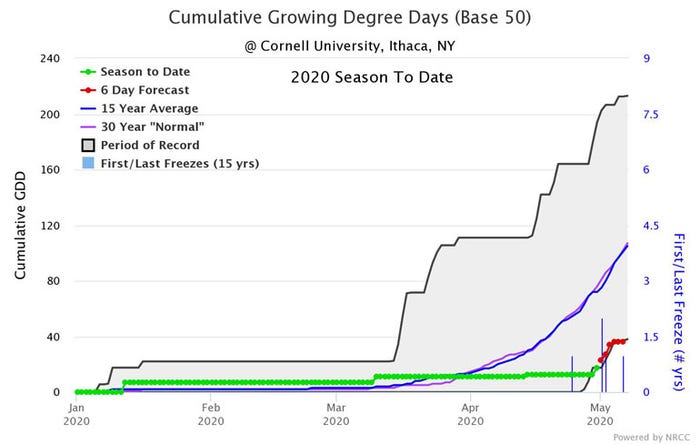
There were a few days of nice weather last week. So nice that some farmers got out and harvested some winter grains.
But then the rains came, again.
After a promising early April that saw above-average temperatures and nice weather in much of the Mid-Atlantic and Northeast, it’s gotten chilly and raw in most places, leaving many choppers and planters parked.
“It’s really strange because it was so warm in March, well-above the 10-year average for growing degree day accumulation, but now in the past couple of weeks it got so cold that things came to a standstill and we hardly got any growing degree days,” says Heidi Reed, agronomy educator with Penn State Cooperative Extension. “Apparently we are still above the 10-year average for total cumulative GDD, but that’s due to the weird spike in March.”
Cornell University’s Climate Smart Farming Growing Degree Day Accumulator shows that Reed is right.
Below is a chart showing growing degree days accumulated for the Lancaster, Pa., with a base of 50 (corn).

The recent cold and rainy weather has dropped GDD accumulation below the 15-year and 30-year averages for the county.
The chart for Ithaca, N.Y., shows an even steeper drop as cold and rain have also stopped GDD accumulation in its tracks.

Access the Growing Degree Day Calculator and enter your ZIP code to see growing degree day accumulation for your area.
Further south in Delaware and Maryland it’s been a little warmer, but that doesn’t mean planters are rolling.
The weekly Crop Progress Report from the National Agricultural Statistics Service shows 8% of corn planted in Maryland, way behind last year’s pace of 18% at this time of year.
Drew Haines of Middletown, Md., says it’s way too cold to plant corn right now.
“In our garden, though, our potatoes have been in the ground for three weeks with no signs of emergence,” he says. “Peas planted the same day are just breaking ground. Things are really slow. April was more like February.”
“There has been some planting done, although I am not sure of the extent due to the shutdown and limited travel allowed by the University,” says Jarrod Miller, agronomy Extension specialist with University of Delaware Cooperative Extension. “It has been cool and wet, enough to slow emergence, but not necessarily stop planting,.”
Figuring out GDD accumulation is fairly simple, but it starts with knowing the temperature base of the crop. For example, corn is 50 because corn doesn’t grow below 50 degrees. Here is a handy GDD accumulation guide by Dave Nanda, director of genetics for Seed Genetics Direct, Jeffersonville, Ohio. Knowing your crop’s GDD accumulation is critical to know if it will fully mature.
Chilled fruit
Meanwhile, some fruit growers in Pennsylvania’s fruit belt have likely lost some crop due to an earlier-than-normal bloom and colder-than-normal temperatures this month.
A temperature inversion during the early morning hours of April 17 likely caused some damage to orchards in and around Adams County, according to James Schupp, professor of pomology at Penn State’s Fruit Research and Extension Center. Temperatures got down to 22 degrees F in the center’s orchards, especially in lower elevations. Some rows of peaches were completely damaged, according to a Penn State report.
Bruce Hollabaugh, production and field personnel manager of Hollabaugh Brothers in Biglerville, Pa., says he’s seeing some losses, too.
“We had a low of 26 [degrees] about two weeks ago, same night as most growers froze,” he says. “We have meaningful loss, especially on stone fruit and apples at lower elevations. We’re certainly not ready to write off the entire crop. Crops at higher elevation on the farm seem to have fared OK.
“Bloom is spectacular on everything this year, so hoping the sheer number of flowers will pull through a crop some in places where it might have been iffy in a lesser-bloom year. Trying to stay optimistic until I know I have no reason to be.”
Even if crop insurance pays out damages, that doesn’t mean that tree management is over.
“Unfortunately, the orchard has to be actively managed during the season after a freeze,” Schupp says. “Peach is a perennial crop, so the trees have to be kept healthy for the next season, plus the grower does not want to allow a lot of pests to go unmanaged and create a large reservoir for the following season.
“One might reduce the number of sprays for some specific fruit issues like brown rot.”
Daniel Weber, tree fruit Extension educator in Adams County, says that damage is likely outside of Adams County.
“From the anecdotal evidence shared by other Extension specialists and educators from across the state, a similar pattern was noticed throughout Pennsylvania,” he says. “Penn State Extension’s Rock Springs location measured a temperature of 22 [degrees] while one orchard in Franklin measured 24 [degrees]. This is well-below the 26-28 [degree] critical threshold for a 10% expected loss for fruit in first and full bloom and goes well into the 90% injury range.”
Growers would be advised to inspect their stone and pome fruit soon.
About the Author(s)
You May Also Like






